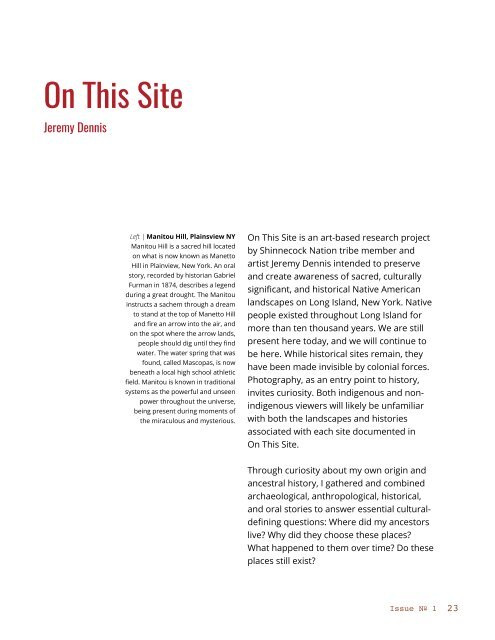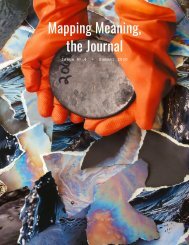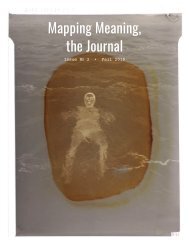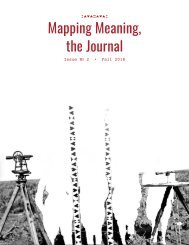Mapping Meaning, the Journal (Issue No. 1)
Create successful ePaper yourself
Turn your PDF publications into a flip-book with our unique Google optimized e-Paper software.
On This Site<br />
Jeremy Dennis<br />
Left | Manitou Hill, Plainsview NY<br />
Manitou Hill is a sacred hill located<br />
on what is now known as Manetto<br />
Hill in Plainview, New York. An oral<br />
story, recorded by historian Gabriel<br />
Furman in 1874, describes a legend<br />
during a great drought. The Manitou<br />
instructs a sachem through a dream<br />
to stand at <strong>the</strong> top of Manetto Hill<br />
and fire an arrow into <strong>the</strong> air, and<br />
on <strong>the</strong> spot where <strong>the</strong> arrow lands,<br />
people should dig until <strong>the</strong>y find<br />
water. The water spring that was<br />
found, called Mascopas, is now<br />
beneath a local high school athletic<br />
field. Manitou is known in traditional<br />
systems as <strong>the</strong> powerful and unseen<br />
power throughout <strong>the</strong> universe,<br />
being present during moments of<br />
<strong>the</strong> miraculous and mysterious.<br />
On This Site is an art-based research project<br />
by Shinnecock Nation tribe member and<br />
artist Jeremy Dennis intended to preserve<br />
and create awareness of sacred, culturally<br />
significant, and historical Native American<br />
landscapes on Long Island, New York. Native<br />
people existed throughout Long Island for<br />
more than ten thousand years. We are still<br />
present here today, and we will continue to<br />
be here. While historical sites remain, <strong>the</strong>y<br />
have been made invisible by colonial forces.<br />
Photography, as an entry point to history,<br />
invites curiosity. Both indigenous and nonindigenous<br />
viewers will likely be unfamiliar<br />
with both <strong>the</strong> landscapes and histories<br />
associated with each site documented in<br />
On This Site.<br />
Through curiosity about my own origin and<br />
ancestral history, I ga<strong>the</strong>red and combined<br />
archaeological, anthropological, historical,<br />
and oral stories to answer essential culturaldefining<br />
questions: Where did my ancestors<br />
live? Why did <strong>the</strong>y choose <strong>the</strong>se places?<br />
What happened to <strong>the</strong>m over time? Do <strong>the</strong>se<br />
places still exist?<br />
<strong>Issue</strong> N o 1<br />
23







